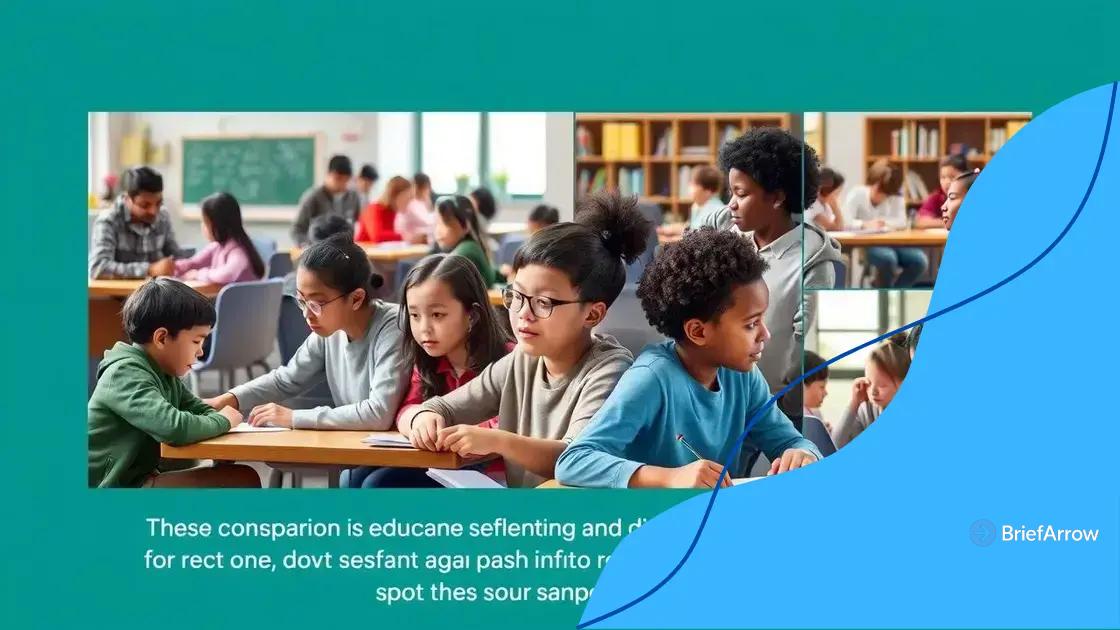State-level debates on school choice initiatives

Anúncios
State-level debates on school choice initiatives focus on funding equity, parental involvement, and the impact of educational options on student performance, shaping future policies in education.
State-level debates on school choice initiatives are gaining momentum, sparking discussions about educational equity and access. Have you thought about how these choices affect your community’s schools?
Anúncios
Understanding school choice initiatives
Understanding school choice initiatives is crucial for parents, educators, and policymakers. These initiatives offer alternatives to traditional public schooling, allowing families to select educational options that best suit their children’s needs.
What are school choice initiatives?
School choice initiatives refer to policies that allow families to choose where their children attend school. This can include options such as charter schools, private schools, and homeschooling. The idea is to create competition among schools, which can improve education quality for all students.
Key components of school choice
- Funding: How schools are funded often influences the availability of school choices.
- Accessibility: Understanding how accessible these options are for families from different backgrounds is essential.
- Performance: Evaluating how different schools perform helps parents make informed decisions.
- Regulations: Each choice may come with specific rules that schools must follow.
Many believe that offering choices leads to better educational outcomes. Parents can find schools that align with their values and their child’s learning style. However, some argue that this can create inequities in funding and resources between schools.
Anúncios
Research shows that school choice can lead to improved student performance in various settings. For example, students in some charter schools outperform their peers in traditional public schools. This suggests that when parents have options, they can better advocate for their children’s education.
As the discussion around school choice grows, it is important to consider all perspectives. Engaging in community discussions can help shed light on how these initiatives impact education.
The debate on funding and equity
The debate on funding and equity in education is a vital topic in the discussion of school choice initiatives. With various options available, how schools are funded can greatly affect the choices families make.
Understanding funding sources
Schools receive funding from a mix of local, state, and federal sources. This mix serves different communities in different ways, influencing the resources available to students. For instance, public schools often rely heavily on local property taxes.
Challenges of equity
- Resource disparities: Schools in wealthier areas frequently have more funding, leading to better facilities and resources.
- Access to options: Not all families have equal access to quality schools due to geographical and socioeconomic factors.
- Impact on student outcomes: Disparities in funding often reflect in student performance and opportunities.
- Policy implications: Understanding how policies affect funding can help make education more equitable for all.
As funding models evolve, discussions on fairness become even more important. Families must weigh their options carefully, considering not just the available choices, but the resources each school can offer. The disparities in funding can lead to unequal educational opportunities.
By examining the nuances of funding and equity, communities can engage in meaningful discussions. This awareness allows parents and policymakers to advocate for a more equitable educational landscape.
Impact on student performance

The impact on student performance regarding school choice initiatives is a significant topic in education today. Choices made by families can lead to varying outcomes for students, influencing their academic achievements.
Research on performance
Studies indicate that school choice can positively affect student performance. In many cases, students in choice programs often achieve higher test scores compared to their peers in traditional public schools. This achievement can be attributed to various factors including enhanced competition and specialized curricula.
Factors influencing performance
- School quality: The overall quality of schools available under choice initiatives can greatly affect student outcomes.
- Support systems: Schools that offer additional support and resources often see better performance in their students.
- Parental involvement: Families who engage actively with their children’s education tend to facilitate improved performance.
- Tailored education: Charter and private schools often provide tailored curricula that better meet student needs.
Additionally, the freedom to choose allows families to select schools that align with their child’s strengths and interests. This personalization can lead to higher engagement and motivation among students, which are critical components of academic success.
On the other hand, it’s essential to acknowledge that not all students thrive equally in a choice environment. Factors such as socio-economic status and access to resources can influence outcomes. Communities should strive to ensure that all families have equal access to quality school options and necessary support.
Parental involvement in school selection
Parental involvement in school selection plays a vital role in the success of school choice initiatives. When parents actively participate in choosing schools for their children, they can significantly influence educational outcomes.
The importance of parental engagement
When parents are engaged, they are more likely to be informed about their options. This helps them select schools that align with their values and their child’s needs. Engaged parents can also advocate for their children more effectively within the education system.
Strategies for effective involvement
- Researching options: Parents should explore different schools, including their curriculum, performance metrics, and extracurricular activities.
- School visits: Attending open houses or school tours allows parents to experience the school’s environment firsthand.
- Networking with other parents: Talking with other families can provide insights into the strengths and weaknesses of various schools.
- Participating in school boards: Involvement in boards or committees can give parents a voice in decision-making processes.
Moreover, when parents choose schools together with their children, it fosters a sense of responsibility and ownership of their education. It empowers students to discuss what they want and need academically. Ultimately, this collaborative approach can lead to more fulfilling educational experiences.
The impact of parental involvement extends beyond the selection process. Parents who stay engaged in their child’s education are also more likely to support their learning at home. This continuous support can lead to better academic performance and positive attitudes toward schooling.
Future trends in education policy
Future trends in education policy are shaping the landscape of school choice initiatives. As educators, policymakers, and families seek the best solutions, emerging trends can lead to significant changes in how schools operate.
Emphasis on technology
One major trend is the integration of technology into education. Digital learning platforms are becoming essential, allowing students to learn more flexibly. Online resources widen access to high-quality educational materials for all students, regardless of geographic location.
Focus on equity
- Equitable access: Policies are increasingly focusing on ensuring all students have equal access to educational opportunities.
- Diverse funding sources: Future policies may explore innovative funding solutions, including public-private partnerships.
- Community involvement: Engaging communities in policy creation is essential to address local needs.
- Data transparency: Sharing performance data can help families make informed choices.
Moreover, there is a growing awareness of the importance of social and emotional learning. This trend acknowledges that a student’s emotional health can significantly affect their academic success. Future policies may emphasize support systems that foster environments where students feel safe and valued.
As societal needs change, educational policies must adapt. Even school choice initiatives will evolve, reflecting new challenges and opportunities. Policymakers will need to remain responsive to the needs of families and students in this dynamic educational landscape.
FAQ – Frequently Asked Questions about School Choice Initiatives
What are school choice initiatives?
School choice initiatives allow families to choose where their children attend school, including options like charter, private, or homeschooling.
How does parental involvement impact school choice?
Parental involvement is crucial as it helps parents make informed decisions about school options that best fit their child’s needs.
What role does funding play in school choice?
Funding affects the quality and resources of schools, influencing the options available to families and the education their children receive.
What future trends should we expect in education policy?
Future trends may include greater emphasis on technology in learning, focus on equity in education, and support for social-emotional learning.